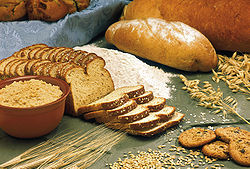
When walking through the bread aisle at the grocery store there are so many choices to choose from that it seems almost impossible to know where to begin. Due to a lack of understanding or because of false advertisements we’ve all been blinded or tricked into buying something that we thought was healthy when really it was not a healthy choice at all. In order to make life in the grocery store a little easier, we’ve put together a list of key ingredients to look out for when buying grains in hope that you will gain a better understanding of the grains you are purchasing and eating. Before looking into what we need to look out for in the grocery store, it is important to know why whole grains are the most important and beneficial carbohydrates to our diet.
Whole grains are important in our diet because they are unrefined grains that haven’t had their bran and germ layers removed. They are better sources of fiber and other important nutrients, like selenium, potassium and magnesium. Whole grains can be either single foods, such as brown rice and popcorn, or they can be found as ingredients within products. While it is still okay to have your favorite slice of Italian White Bread, try to make half of the grains you consume each day whole grains.
Examples of whole grains are brown rice, buckwheat, bulgur, millet, oatmeal, quinoa, rolled or whole oats, whole-grain barley, whole-grain corn, whole rye, whole wheat and wild rice.
When reading labels, look for the following:
Brown bread: This bread may or may not be made using whole grains. Be sure to read the ingredients because many brown breads are made with white flour and with added brown molasses.
Refined flour & grains: Refining involves removing the course parts of food products. For example, refined wheat flour is flour in which all but the internal part of the kernel has been removed. Through refining grains, many nutrients are removed.
Enriched/Fortified flours & grains: These are refined foods which have added nutrients.
Unbleached flour: Flour which has been refined but not bleached; it is very similar to refined white flour in texture and nutritional value.
Wheat flour: Consists of any flour made from wheat. Examples include white flour, unbleached flour, and whole wheat flour.
Whole grains: Whole grains are unrefined and contain the entire kernel, consisting of the germ, endosperm and bran layers. Whole grains and flours are the most nutritious, providing vitamins, minerals and fiber.
Keeping these shopping tips and nutrition facts in mind, make it a goal to start reading labels and looking for breads and pastas that are 100% whole grain!

